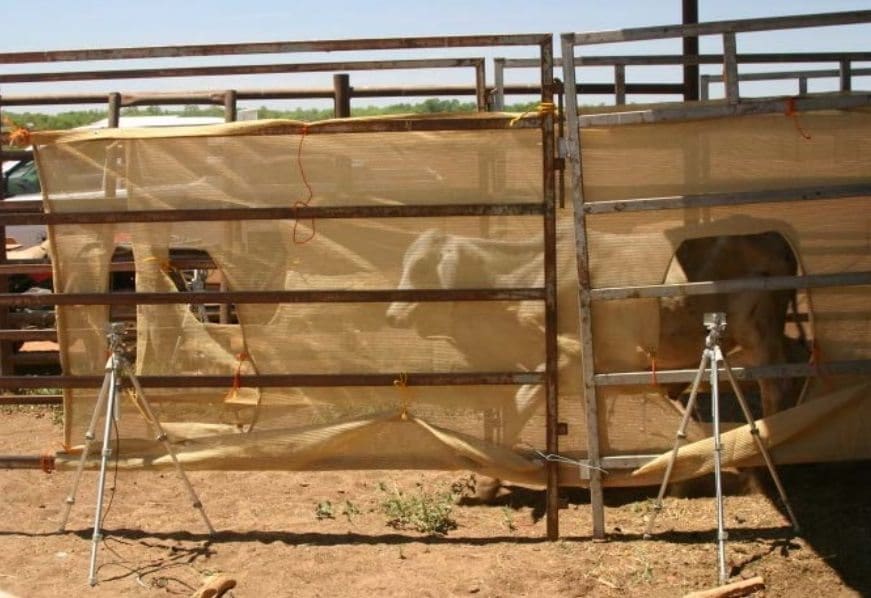
Measuring flight speed in Brahman weaners exiting the crush, tripping two light beams mounted on tripods.
TEMPERAMENT continually ranks as the most important trait among Australian beef producers.
The Australian Beef Breeding insights, published by Angus Australia, ranked traits of importance on a ten-point scale, from 0 (least important) to 10 (most important). Among users of Angus genetics, temperament was rated at 9.2, while non-Angus users rated the trait at 9.4.
As a trait, temperament ranked above polledness, visual assessment on structure and even passing a Bull Breeding Soundness Examination.
Temperament is certainly not a new trait for beef producers to consider. Most producers understand temperament is heritable and as result it is one of the factors behind its primary focus in selection.
However as with any genetic trait, there are other factors that influence the expression within the phenotype. Some of these factors have been presented as part of the research published from the Southern Multibreed (SMB) Project, and presented at the recent 2025 AAAGB Animal Genetics Conference in New Zealand.
The research presented by Dr Brad Walmsley and a team from the University of New England and NSW Department of Primary Industries, highlighted the findings from the SMB Project where temperament was assessed in almost 4000 animals across six major breeds: Angus, Hereford, Shorthorn, Charolais, Wagyu, and Brahman.
The project used two key measurements: Flight Time (FT), how quickly an animal exits a crush after release (see photo above), and Crush Score (CS), a subjective assessment of how an animal behaves while restrained in a crush.
Temperament traits change with age
The research demonstrated that temperament traits change with age, sex, and handling history. The researchers reported moderate heritability for both FT and CS, with steers showing FT heritabilities between 0.27 and 0.31 and heifers between 0.15 and 0.25.
For Crush Score, heritabilities were 0.24 to 0.25 in steers and slightly higher, 0.29 to 0.36 in heifers. These results support what many beef producers know, which is that it is possible to select and breed cattle with more acceptable levels of temperament.
While there is a genetic component to temperament, based on the heritability estimates presented, about 65–75pc of the variation in temperament traits is influenced by environmental and non-genetic factors such as handling, yard design, and previous exposure to people.
Heifers were more likely to become habituated to repeated handling, appearing calmer over time – not because they were genetically quieter, but because they had learned to tolerate human interaction
In particular, the study showed that heifers were more likely to become habituated to repeated handling, appearing calmer over time – not because they were genetically quieter, but because they had learned to tolerate human interaction.
This behavioural adaptation, while it is valuable in practical terms, may mask the true genetic temperament of an animal if not accounted for.
A bull may appear calm and well-behaved at sale, but this behaviour is often shaped more by his environment than his genetic predisposition. Frequent handling, quiet facilities, and regular human interaction can condition an animal to appear more docile, masking underlying temperament traits.
In some cases, this environmental influence may overshadow the bull’s true genetic merit for temperament. This is why BreedPlan recommends recording temperament at weaning, before habituation has a chance to influence behaviour. When selecting sires, producers should weigh both the bull’s current behaviour and what his recorded data tells them about his long-term potential to sire progeny with consistently calm temperaments.
An additional finding from The SMB showed that the expression of temperament is not the same in steers and heifers.
Steers tended to show more stable flight time responses between weaning and yearling stages. In contrast, heifers’ temperament scores were more variable over time, likely due to their ongoing exposure to handlers in research station settings. These differences highlight the importance of recording temperament in animals at earlier ages and under less familiar conditions to capture inherent behaviour more accurately.
Lessons when buying this year’s bulls
For beef producers heading into bull sale season, this work confirms the importance of temperament as a trait to consider. While temperament is heritable and worth selecting for, care is needed to ensure the scores being used reflect genuine genetic differences, not just good handling or preparation.
Secondly, it is essential not to rely only on genetics for herd improvement. Management practices, especially in early life and in high-stress moments like weaning or feedlot induction, has a powerful effect on behaviour.
Good stockmanship, low-stress handling techniques, and well-designed facilities are just as important as selecting the right bull.

Alastair Rayner
Alastair Rayner is Principal of RaynerAg and an Extension & Engagement Consultant with the Agricultural Business Research Institute (ABRI). He has over 28 years’ experience advising beef producers and graziers across Australia. Alastair can be contacted here or through his website: www.raynerag.com.au